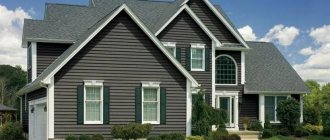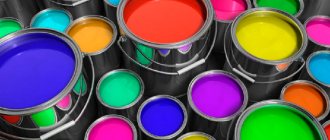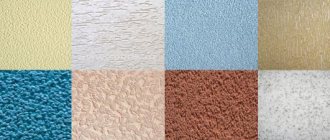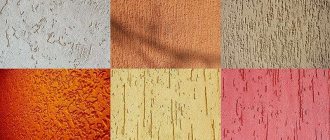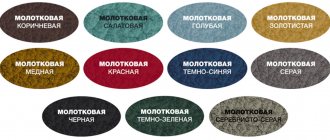Description, composition, GOST
The paint contains perchlorovinyl resin, which has binding properties. The material includes fillers and pigments, for the dissolution of which xylene or solvent is used. This is a durable façade covering with valuable quality characteristics.
The material is universal, so it is used for lining cement and concrete bases. Perchlorovinyl paints for facades are used for painting walls made of wood, metal, and plastered surfaces. The material has a certificate of compliance with GOST 25129-82 standards. The finish is resistant to high temperatures. It is not capable of freezing at negative temperatures, which range up to -20 degrees. This characteristic allows the paint to be used for decoration in summer and winter.
Enamel is produced in a wide range of colors, which allows the client to choose the most suitable option according to the intended desire and design. The material is elastic and vapor-tight.
When painting, the exposure to moisture on the base is limited.
Advantages and disadvantages
Enamel is used for design in the metal and shipbuilding industries. Advantages of the material:
- There is no need to prepare the surface before applying enamel.
- After application, the material penetrates deeply, which guarantees its strong adhesion to the base. This leads to strengthening the structure of the base and protecting it from the influence of negative external factors.
- The enamel has an optimal working viscosity, which allows it to be applied with a brush or spray.
- The material can be tinted in 25 shades.
- The enamel is supplied ready-made, so work can begin immediately after purchase.
- Enamel is characterized by a wide variety and richness of colors.
- The finish fully tolerates frosts down to -20°. it does not crack or swell.
- The pigments of the material are not affected by ultraviolet radiation, so the finish retains its original appearance for at least 3 years.
- When applying the material to metal, its protection against corrosion is guaranteed.
- Dried enamel is elastic, so it does not deform during vibration and slight shrinkage.
The disadvantage of the material is that it is flammable, so the facility is equipped with fire extinguishing means. When volatile components evaporate, a pungent odor appears. Therefore, it is recommended to use personal protective equipment when applying the composition.
Technology of painting facades with perchlorovinyl paint
CAREFULLY! The presence of aggressive volatile substances requires the use of personal eye and respiratory protection.
- To apply the coating you will need a dry and clean base . All lights, air conditioners, antennas or other attachments must be removed from the façade. It is recommended to remove trim from window or door openings.
- Clean the surface from dirt, peeling or shedding.
- Cracks, chipped or crumbling areas should be filled with putty , and in difficult cases, a leveling layer of cement (or other) plaster should be applied.
- To apply the material, dry weather is required ; exposure to direct sunlight is undesirable, since the correct crystallization process is disrupted, the coating layer immediately dries out, and subsequently cracks.
- Paint is applied by spraying or manually using a roller or brush.
NOTE!
If work is carried out at subzero temperatures, the material must not be diluted with water, as this will damage the coating. Perchlorovinyl facade paints are a high-quality finishing coating that has a successful set of qualities and is optimized for temperate climate conditions.
The versatility of the material, the ability to maintain its performance qualities throughout its entire service life and the availability of specialized grades for non-standard operating conditions make the material a serious competitor to many domestic or foreign models of facade finishing coatings.
VKontakteFacebookTwitterGoogle+Odnoklassniki
Perchlorvinyl facade paint HV 161: characteristics
The facade material has good technical characteristics, therefore it is used for cladding private houses and cottages, public premises:
- It is recommended to apply the paint at a temperature of +40-20 degrees due to its resistance to atmospheric agents.
- The enamel is not susceptible to the influence of aggressive substances of chemical origin - oil, gasoline, etc.
- The percentage of dry residue has a limit of 43-47.
- After applying the material, it dries within 4 hours. The bending elasticity level is 5 millimeters. The material has a long service life and can withstand 50 cycles of freezing and thawing.
HV-161 perchlorovinyl facade paint
Facade paint XB 161 is:
Facade paint XB-161 (Enamel XB-161) is a construction varnish that is used for painting architectural structures and facades of various buildings made of brick and concrete.
Enamel XB-161 is a suspension of 10% perchlorovinyl varnish, with the addition of pigments and fillers. Thanks to this chemical composition, perchlorovinyl paint XB-161 can be applied at subzero ambient temperatures.
xv 161 technical specifications
Once applied to the surface, XB-161 paint dries within 4 hours at an average temperature of 18-22 degrees Cº.
The film of façade perchlorovinyl paint that forms after drying, according to GOST, has a bending elasticity of no more than 5 mm.
The conditional viscosity of the paint is determined using a VZ-246 viscometer, the nozzle diameter of which is 4 mm. at temp. 20 degrees Cº, and is 35-70.
The degree of grinding varies up to 140 microns. This is an important indicator, because Grinding is the grinding of pigment particles included in the paint. For XB-161 paint, the degree of grinding affects the protective properties of the coating and the ability of the paint not to delaminate during storage.
The paint contains up to 47% non-volatile substances. Thanks to such a rich pigment content, XB-161 perchlorovinyl facade paint has good hiding power and protective ability.
paint hv 161 perchlorovinyl:
The XB-161 paint does not have GOST standards; it is produced according to the Technical Specifications of the 1992 release. According to them, a conventional distinction is made between XB-161 perchlorovinyl facade paint of grades A and B.
Paint ХВ-161 grade A is applied to a previously prepared surface or over an old coating. ХВ-161 B is used for restoration work.
XB-161 does not change its characteristics depending on the brand. The brand will be indicated on the XB-161 paint certificate.
HV 161 perchlorovinyl facade paint:
lays flat on pre-plastered brick and concrete surfaces of building facades and architectural structures, forming a homogeneous film.
Perchlorvinyl façade paint, grade xv 161, is resistant to atmospheric and water influences. XB-161 enamel has a wide range of colors, including more than 25 shades. The price of XB-161 depends on the color. Bright, saturated colors of XB-161 paint are more expensive than pastel or light ones.
XB-161 enamel after application to plastered surfaces forms a homogeneous film.
Service life is at least four years in temperate climates.
Recommendations for the use of XB-161 paint
Before applying façade paint of the perchlorovinyl brand xv, you should check the surface to be painted. For ideal application of paint and longer-term preservation of its properties, it is necessary that the surface to be painted is smoothly plastered, has no cracks, is dry and clean. If the surface to be painted was previously coated with acrylic, organosilicon or silicate materials, you should not apply paint to such a surface or clean it.
No XB-161 manufacturer will provide a guarantee for the coating if this condition is not met. Before direct use, you should stir the paint to prevent it from thickening and forming lumps.
XB-161 paint can be applied with a roller, brush or pneumatic spray. Before applying paint using a pneumatic sprayer, it should be diluted with xylene, solvent or a mixture of them until a working viscosity is formed. It is recommended to apply paint with a roller or brush at final viscosity.
Paint consumption XB-161
for a two-layer coating ranges from 300 to 400 grams per square meter. m.
paint hv 161 application characteristics
HB-161 enamel is applied to the surface using a brush, roller, or spray gun.
Perchlorovinyl facade paint is stored in places protected from fire at a temperature of -10 - +20 degrees Cº. Guaranteed shelf life is 12 months from the date of manufacture. HV-161 paint is certified and complies with GOST 25129-82.
For the wholesale sale of paints and varnishes there is a special price.
You should buy XB-161 or place an order by phone. The price of perchlorovinyl façade paint XB-161 depends on the volume. During the renovation season, you can buy XB-161 paint at a discount. Having decided to buy enamel, call the sales department with a request: (4852) 59-99-09, send a request from the website, or the quick order form at the bottom of this page
Other types and manufacturers
Perchlorovinyl enamels have different modifications, according to which they are intended for finishing premises located in temperate and tropical climates. In Russia, materials from the XB series are used with the following markings:
- 125. Before applying the composition, the surface is not primed. Consists of fillers - plasticizer, aluminum chips, talc. Used for cladding metal and wood surfaces.
- 182. When using enamel, a preliminary primer is carried out. It has a slight dry residue and is used for finishing decorative elements.
- 161. Frost-resistant finishing material for facades, which is used in temperate climates. Used for coating plaster, concrete, brick.
In our country, popular manufacturers of perchlorovinyl paints are PKF Spectr, NPF Enamel, LKM.
Other types and manufacturers
There are various modifications of PVC paints that are intended for use in different conditions:
- In a temperate climate.
- In a tropical climate.
This division is due to the large difference in operating conditions of the coating in different regions, which requires some changes in the composition and the presence of certain additives.
The most common types in our country are:
- XB-125 . Enamel that does not require prior priming. Contains talc and aluminum chips and a plasticizer as a filler. Used on metal substrates, it can be applied to wooden structures.
- XB-161 . Frost-resistant facade paint, intended for use in temperate climates. Suitable for any substrate, but the main purpose is concrete, plaster or brick.
- XB-182 . This paint requires preliminary priming. It has a smaller dry residue and is used mainly for decorative purposes.
The most commonly used brands of material are listed; the list of PVC paints is much wider, and moreover, it is constantly being updated.
Manufacturers of PVC paints in our country are:
- Paint and varnish plant in Yekaterinburg.
- CJSC PKF Spectr.
- SPF "Emal" and many other manufacturers.
Application area
Perchlorovinyl enamels of grade A are used for finishing the facades of buildings that have concrete, brick or plastered walls. Grade B enamel is a material used to paint important architectural structures.
The enamel should only be applied to a flat, clean and dry surface that does not have loose plaster or cracks. If organosilicon, lime, silicate, or acrylic materials were used to paint surfaces, they must be cleaned before applying perchlorovinyl enamel. Painting of walls is not carried out if their temperature is less than 5 degrees.
Technology of façade cladding with perchlorovinyl paint
Before tiling a room, a person must wear personal protective equipment, since the material contains aggressive volatile substances.
- The composition can only be applied to a dry, clean surface, so it must be prepared first. If there is old peeling plaster, it is removed using a spatula. The cracks are sealed with cement-sand mortar and left for 2 days until completely dry.
- The first step is to dismantle air conditioners, lights, antennas and other attachments from the façade of the building. If there are platbands on doorways and windows, they are removed.
- It is recommended to apply the material in dry weather. During the procedure, make sure that direct sunlight does not fall on the surface. Therefore, shaded areas are pre-painted. During the day, the sun moves and shadows appear in new places. This allows you to paint a room from 4 sides in 1 day.
- If work is carried out in the cold season, then diluting the enamel with water is prohibited. For this, special solvents are used - solvent, xylene. If the surface is dry and free of ice, then work is carried out at a temperature not lower than 20 degrees.
- It is allowed to re-apply paint to a surface for which perchlorovinyl materials were previously used.
- Apply the finish with a brush or roller. Due to the optimal consistency of the composition, the enamel can be sprayed from a spray bottle.
In order to ensure high-quality adhesion of the enamel to the surface, it is recommended to use a primer and putty for surface preparation, which have a perchlorovinyl base.
Conclusion
From all of the above, one simple conclusion can be drawn: this type of enamels and paints fully justifies its popularity, despite its relatively recent appearance on the markets. Those disadvantages that are associated only with the specifics of the application are more than compensated for by durability and low cost.
You can learn more about this issue from the video in this article.
- Serious protection from adverse climatic influences (moisture, frost);
- Very high adhesive properties, allowing to reliably protect the walls of the building from moisture penetration;
- The widest range of possible uses - paint of this type can be completely safely applied to brick, wood or concrete walls, as well as to any plastered surfaces;
- The ability to carry out work in Russian winter conditions, at fairly low temperatures. The fact is that perchlorovinyl paint does not thicken even at ultra-low temperatures (below - 15 degrees Celsius).
- Bright, deep and very rich color, capable of maintaining its original appearance for 2-3 years.
Among the disadvantages of perchlorovinyl paint, which every owner should also be aware of, we note the following:
- It is impossible to paint facades during snowfall or rain. The main condition for the paint to firmly and reliably “grab” the base is 100% dryness of the surface.
- You cannot paint walls that are exposed to direct sunlight while the paint is drying. The fact is that ultraviolet light dries paint much faster than required by technology. This causes the paint to crack and fall off. The ideal temperature for painting is 15 - 20 degrees Celsius.
- Low elasticity of paint is a disadvantage resulting from the inclusion of many pigments in its composition. Keep in mind that any curvature of the facade leads to cracks in the paint layer. For this reason, it is highly advisable to apply perchlorovinyl paint to the surfaces of an already settled house.
We also note that all the existing shortcomings of the paint are more than offset by its most important advantage - its relatively low price. Coupled with a large number of advantages, it is the low cost that makes this paint an increasingly popular solution for painting facades among Russians.
[Click on photo to enlarge]
READ MORE: 220V voltage stabilizer for a dacha, which device to choose
Paint consumption per m2
For cladding buildings, it is recommended to pre-purchase the required amount of enamel. To calculate it, you need to know the material consumption. It depends on indicators such as color and working viscosity of the enamel. The calculation takes into account the surface texture. For cladding smooth walls, less enamel is used than for rough ones. To calculate the amount of enamel, the method of its application, the number of layers and the thickness of each of them are first determined.
On average, to cover one square meter of surface with one layer you will need from 150 to 200 grams of enamel. If a two-layer application is carried out, then the consumption increases to 500-600 grams.
The average price per kilogram of material is 140 rubles. It depends on the manufacturer and region of sale. Perchlorovinyl enamel is the best option for finishing a room and creating an original design. It is durable, has good strength characteristics and is easy to apply to the surface.
